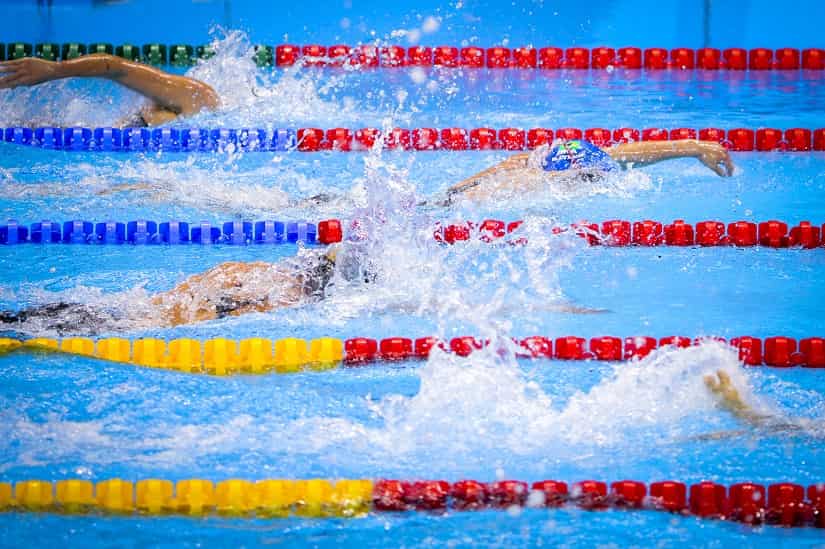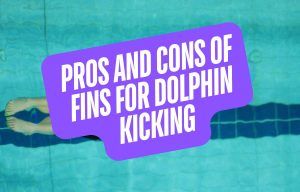The pull buoy is one of the most common swim aids you will see at the end of a swimmer’s lane. Here is a detailed look at what pull buoys are, the pros and cons of pull buoys, and how to use them properly.
Over the course of a swim practice, there is always a swimmer or two in the group who pipes up:
“Can I do this set with my pull buoy?”
If you’ve heard these words before then you have trained with The Specialist. Or maybe you are the Specialist.
You know, that rare swimmer who can pull faster than they can swim.
The appeal of the pull buoy is strong and obvious—we can simply swim longer and with less effort with one than we can without one.
It’s flat-out easier.
Which in theory sounds nice, but in reality, doesn’t always mean it serves our goal of becoming a faster swimmer.
Here is a more complete look at the benefits of swimming with a pull buoy, some key pitfalls, and how to maximize the use of a pull buoy when you hit the water.
Let’s dive right in.
What is a Pull Buoy?
A pull buoy is a foam buoy that is designed to provide extra buoyancy in the hips and force swimmers to focus on the pulling motion of their swimming.
Pull buoys are excellent for upper body training, reinforcing better body position, and mixing things up in swimming workouts.
Pull buoys come in a variety of shapes, colors and prices, including a figure-eight one-piece foam buoy, dual-cylinder foam buoys, or a one-piece buoy with a bell end for extra buoyancy.
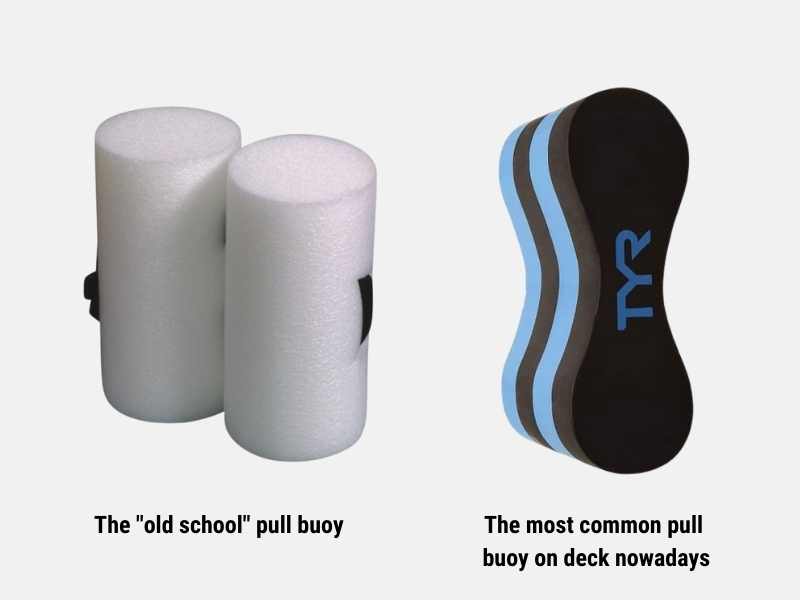
Pull buoys were invented by Fred Carbonero, a swim coach, in the mid-1960s and were originally designed to be a tool for added resistance in the water.
The thick dual-cylinder design caused significant drag.
Pull buoys have become more streamlined over the years and are now more of a buoyancy aid than a resistance tool.
The Benefits of Training with a Pull Buoy
When used properly and with intent, grabbing and using your very best pull buoy can be a very powerful tool for better swimming and for getting the most of your swim practices.
It can be easy to make the case for its use based on the following arguments:
1. Teaches you proper body position.
Fast swimmers ride the surface of the water. They glide across the pool, their hips high, giving them a slim profile in the water. When a swimmer’s legs drop, drag shoots through the roof.
The pull buoy helps us to achieve a more efficient body position by keeping our butts nearly dry and our feet dangling at or just below the surface of the water.
The idea is that by being better able to feel proper body position we can transfer this over to our regular swimming.
We learn how efficient swimming should feel like.
2. Pull buoys isolate the upper body.
There are a myriad of reasons why you would want to do this—your legs are gassed, it’s a recovery workout, or you simply want to level up your upper body strength.
You can isolate your arms, shoulders, and back with the use of a pull buoy.
Next!
3. It is less taxing than swimming.
Our legs demand a lot in the water. While flutter kicking may only provide a fraction of actual propulsion, it contributes to overall swimming speed in other ways, particularly with keeping proper body position in the water.
This contribution comes at a cost—our legs are incredibly oxygen-thirsty and can leave us feeling winded quickly. The pull buoy allows us to train for longer, allowing us to develop increased upper body fitness.
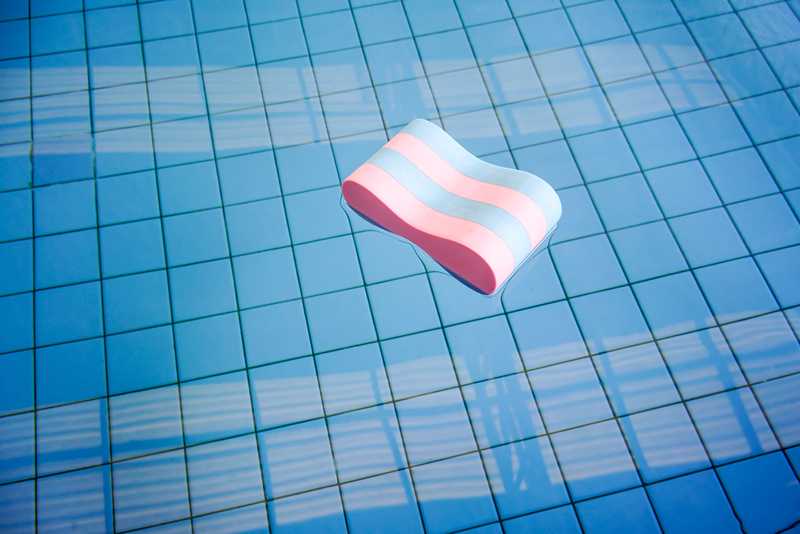
4. A pull buoy can help you focus on better technique.
Swimming faster is equal parts conditioning and efficiency (i.e. awesome technique!). I find that when using a pull buoy it’s easier to focus on that high elbow catch and a balanced arm stroke because there is simply less to focus on.
With the focus solely being upstairs you can devote all your mental energy to improving your pulling technique.
5. Work on arm mechanics independent of your legs.
Some swimmers have such a hopelessly awful kick that the only way they can develop the fundamentals of a better arm stroke is to use a pull buoy and completely isolate the movement.
It allows these swimmers to experience moving through the water as though they had a better kick and proper leg and hip positioning.
6. It is helpful with breath control work (and even improving your walls).
As an age group swimmers, long course swim practices were always fertile ground for lung-buster sets. It wasn’t uncommon to see coaches write up breathing patterns of 5-7-9 when doing pull sets.
These are great for helping us learn breath discipline.
In addition, while doing pull sets I find that flip turns can be better addressed because you aren’t so out of breath and scrambling for air between the flags and the wall—as a result, you can swim in and out of the wall without breathing, resulting in generally faster turns and breakouts, a small but sharp positive.
7. Combined with paddles and a band can be a heckuva workout for your arms.
Swimming with a pull buoy might be “easier” but add a pair of paddles and a band to the equation and things start to get a whole lot harder.
Swim paddles are an excellent tool for pulling strength and power. Incorporating a band can also reduce the slight “cheating” swimmers do when they kick when doing a pull set.
If you want to get truly serious about developing upper body power and strength ditch the pull buoy and go strictly with the band around your ankles.
It’s great for stroke rate, stroke power, stroke awesomeness, etc etc.
8. Good for improving feel for the water.
The debate in the competitive swimming community has almost always been quality versus quantity in training. I sit somewhere in the middle, with larger yardage sessions being helpful for one thing in particular–helping you improve your feel for the water.
Doing long pull sets isn’t the most exciting thing in the world for most swimmers, but as a sprinter, I actually enjoy them. My stroke always feels a little more dialed in afterward.
Because you can *generally* do pull sets longer than regular swimming there is more time spent working on the arm stroke, and more time improving your hand’s relationship with the water.
Alexander Popov, the Russian sprint legend who dominated the 50m and 100m freestyles for a decade, did long, unbroken swims in practice. The goal wasn’t necessarily aerobic work, it was a conscious effort at playing with his stroke to test what was most efficient.
Long pull sets–when done with correct form, of course–are great at improving your feel for the water.
The Disadvantages of Training with a Pull Buoy
Of course, with any piece of swimming gear, whether we are talking about swim fins, paddles, or in this case, a pull buoy, there is the temptation to cross over from tool to crutch.
If swimmers are constantly reaching for the pull buoy to avoid having to do proper swim or kick work then it’s almost certainly a case of the latter.
When we lean on the pull buoy we start avoiding some of the critical aspects of our swimming, from using the full kinetic chain to having incorrect stroke technique.
The use of the pull buoy can also produce the following downsides:
1. Limited hip rotation.
Power in your arm stroke doesn’t just come from your arms and shoulders—a lot of it is derived from your hips. Throwing a pull buoy between your legs tends to make your hips flatter, which will slightly reduce your stroke length.
Having proper hip rotation while rocking out with your pull buoy is tough—try doing catch-up drill while doing pull and you will know what I mean.
The difference isn’t always noticeable, but it’s there. You’ll notice that over the course of a long course 50m your stroke count will go up by a handful of strokes.
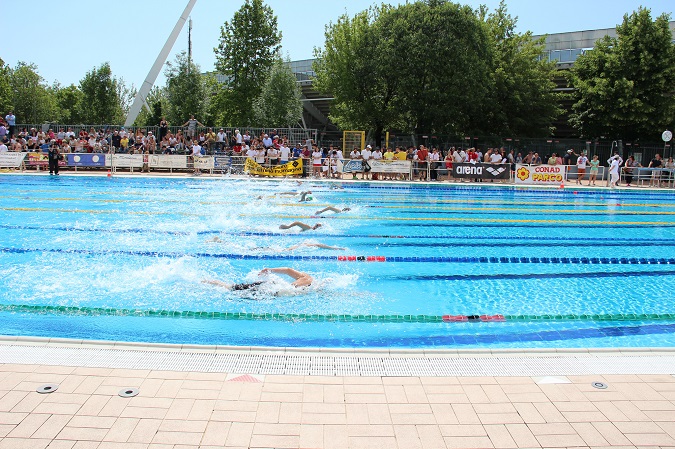
2. A pull buoy makes us reliant on it for proper hip and body position.
If the pull buoy created resistance on our hips it might make proper hip positioning easier once we took it off—but it doesn’t. A pull buoy gives our hips an artificial lift–but the moment we take them off they plunge to the bottom of the pool.
Having our hips nice and high might give us the impression of what we should be swimming like, but it doesn’t necessarily make it so when we start swimming again.
3. Breaks the kinetic chain.
Efficient swimmers are able to fly through the water because their whole body works together to make this happen.
Everything from their fingertips, head position, hip rotation, to the whipping motion of their toes works together as one large system to create propulsion.
When we isolate parts of this system—in this case with a pull buoy–in the name of “strengthening” it’s less time we are spending becoming more efficient at the whole system.
4. Less work on your core.
Swimmers rely extensively on core strength for stability in the water.
It acts as a platform and conduit for our swimming (back to that whole body system thing again). What ends up happening when we put a slippery pull buoy between our legs is that it replaces the core–the power-broker for our swimming.
The folks over at AquaVolo say it best:
“The pull buoy provides artificial support and in essence relieves the core of its duties. The core no longer needs to provide a base of support, stability, balance, transfer of power or the link between the arms and the legs. All these tasks are outsourced to an artificial device: a pull buoy. The core can just sit back and relax.”
How to Use a Pull Buoy Like a Champion
Wherever you stand on using our pull buoy, whether refusing to release it from your sharp talons or not, there are some things you can do to insure that this tool is serving your goals in the water first and foremost:
Position it close to your hips
A pull buoy is a buoyancy aid. Place it as close to your hips as possible for maximum buoyancy.
Placing it down by your ankles, something I see a lot of beginner swimmers do, places undue strain on your lower back and throws off your body position. With the pull buoy by your ankles, your knees and hips will sink, forcing you to snow-plow through the water with brutal body position.
Pull buoys, when used properly, keep your hips nice and high in the water.
Pair it with a band and/or paddles for maximum upper body isolation
A pull buoy won’t complete eliminate the leg movement and flutter kicking. Swimmers will often “cheat” their pull sets by kicking lightly.
Placing a band around your ankles ensures that you are really isolating the pulling motion and eliminates any kicking.
Pulling with an ankle strap is a more advanced variation of pulling and should not be done by swimmers with poor technique or shoulder injuries.
And of course, adding paddles to your pulling work can increase the upper body emphasis. The added speed that comes with paddles is a fun way to invigorate your training, as well.
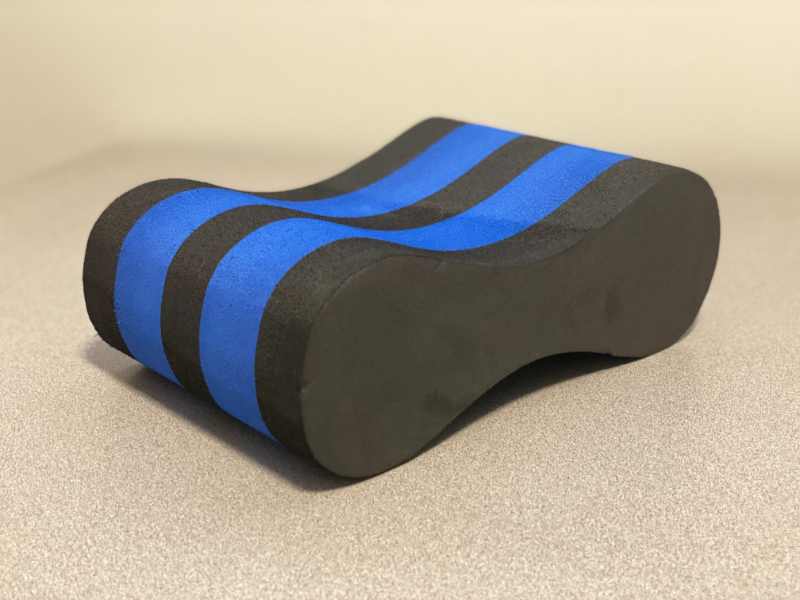
Alternate pull buoy and swimming.
If you use the pull buoy as an instructional tool (and ya should!) for better technique, alternate its use with regular swimming.
For instance, you could perform a set of short course 100s alternating pull/swim by 50, where you do pull with a killer early vertical forearm catch and high hips—and then perform the swim rep as if it is still there.
One favorite set that I’ve used consistently over the years is as follows:
- 8-12×200 freestyle, as 100 pull, 100 swim, on an interval where I am getting around :20 rest.
Use it for targeted work.
Just like using swim fins, a kickboard, or a swimmer’s snorkel, a pull buoy should serve the overall goal that you have for yourself in the pool.
Too many swimmers will lean on using a pull buoy simply because it is easier to do so, and not use it tactically and in service of what they want to accomplish in the water.
When doing pull sets don’t just focus on a strong arm motion, address other areas of your swimming:
- Hold a specific breathing pattern. As mentioned earlier, pull sets are awesome for breath discipline. Breathing bilaterally, or holding a higher than usual breathing pattern is easier during pull sets, so take advantage of this in order to help improve breath discipline while swimming.
- Charge into the walls. Even though you should make swimming in and out of the walls like a boss habitual, it is easier to work on during pull sets because you aren’t so winded. Make a point to swim fast into the turn, not breathing the last few strokes into the wall.
- Target a specific technical element of your stroke. There is no such thing as “technique work” in swimming–it’s all technique work! When doing pull address a weak point in your stroke–the high elbow catch, for instance, so that you are getting the upper body work + technique work as well.
What is the best pull buoy for swim training?
Choosing a pull buoy is fairly straightforward. Pull buoys come in symmetrical and asymmetrical shapes. The latter gives you options in how much buoyancy you want for your hips. Pull buoys are also very inexpensive and last forever.
The Speedo Team Pull Buoy has an asymmetrical shape that is perfect for adjustable buoyancy. On days when you want more lift, place the wider bell end under the body.
The Takeaway
I can say with absolute certainty that my pull buoy isn’t going anywhere. I use it for warming up, for breath control work, and for head-down sculling with a snorkel.
It’s been a part of my swim practices since the very beginning–along with my big, ugly green kickboard. But does that mean it’s the most effective way to become a better swimmer?
Not necessarily.
Be realistic about why you are using your pull buoy and use it with full intention.
Are you strapping on the pull buoy because it is easier than doing swim work?
Or because there is something you want to accomplish outside of being a better pull specialist?
Instead of just swimming with it because it feels easier, or because it’s “the way it has always been done”, or because of nostalgia, consider truly thinking whether or not the pull buoy is effectively serving your goal of being a better and faster swimmer.
More Guides Like This
How to Improve Your Breaststroke Pull with Olympian Mike Alexandrov. Two-time Olympian and NCAA breaststroke champion Mike Alexandrov stops by to share a breaststroke drill progression designed to improve your breaststroke pull from top to bottom. Includes video demonstrations.

